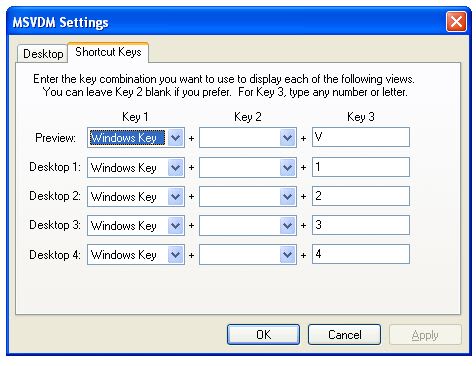
- #Virutal desktop manager update
- #Virutal desktop manager windows 10
- #Virutal desktop manager software
- #Virutal desktop manager zip
I'm trying to work on these issues, but if you have a solution, just throw in a PR and I'll take a look.
#Virutal desktop manager update
The icon will automatically update up to 999 desktops (can you handle that many?). If this hotkey doesn't work on your system (Intel utility already uses it), you can open up the settings and select the alternate hotkey (Shift+Alt+Left/Right).Īs of v1.5.0, you are no longer limited to 9 desktops. With this hotkey, you can cycle through your virtual desktops. I have added a listener to the hotkey of Ctrl+Alt+Left/Right.
#Virutal desktop manager windows 10
Otherwise, click Browse, and then navigate to the Windows 10 Enterprise. If using the DVD, the program automatically finds the Windows 10 Enterprise. Under VDI Tasks, click Create virtual desktop, and then browse to your Windows 10 Enterprise. Focus on your desktop apps and policies while Azure manages the rest. Open MultiPoint Manager, and then click the Virtual Desktops tab. Set up automated scaling and manage your images efficiently with Azure Shared Image Gallery. Configure network settings, add users, deploy desktop apps, and enable security with a few clicks. You can continue to use the default hotkey to change desktops (Ctrl+Win+Left/Right), but you won't get any of the benefit of the program except knowing which desktop you are on. The Azure portal is your management hub for Azure Virtual Desktop. You can use Task Scheduler to make it launch when you login so you don't have to launch it manually every reboot.
#Virutal desktop manager zip
zip from the Releases, extract it and then run VirtualDesktopManager.exe. And unless the program has been updated to understand virtual desktops and cloaking, the programs won’t even realize that they’ve been hidden from the user.This program was made for people who are using Windows 10's built-in Virtual Desktops, but who don't like the default key-binding, don't like how you can't cycle through your desktops (If you are on your last one you don't want to hotkey over to the first one 8 times), and don't like not knowing what desktop # they are on.

Aside from being removed from view, the programs continue to run normally. Virtual desktops give you a way to organize your work, to remove distractions, and to switch between contexts. You can display all desktop environments using the Ctrl-Tab key, mouse or hot corners.

It can be used to create up to 64 desktop environments that you can switch between using hotkeys that you define in the interface or the program's system tray icon. They can sit down at a hospital computer, then pick up. The virtual desktop program is free for personal use only. Wherever they go in the hospital, whichever client they’re using, the desktop is available. Uses same control plane & management as VMware Horizon and supports the features of Azure Virtual Desktop. They want to separate one thing from another. VMware-managed DaaS platform that delivers virtual apps and desktops from Microsoft Azure. This is to provide them with multitasking work or organize their projects. And before Window 10, some users would search for an effective Windows virtual desktop manager.
#Virutal desktop manager software
Programs running on non-current virtual desktops still run as they did before. Windows virtual desktop manager is not a built-in software in the previous version of Windows like Windows 9, 8, 7, XP. Organizing windows into virtual desktops tells the system which windows you would like to see together, and which you would like to be hidden automatically. They take up as much CPU, RAM, and other resources as they normally would if they were switched away from by other means.

Switching away from a virtual desktop does not do anything to the programs running on that virtual desktop. I noted some time ago that virtual desktops are a window management feature, not a security feature.


 0 kommentar(er)
0 kommentar(er)
